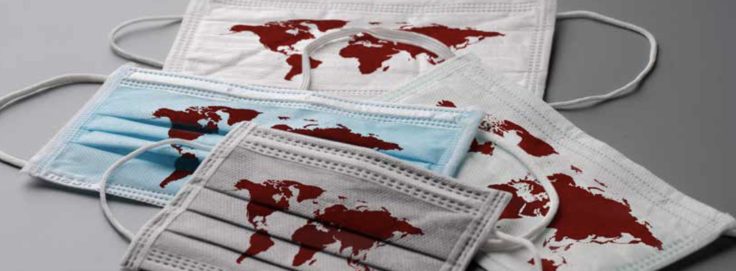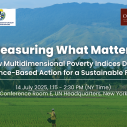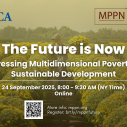
Search
National Multidimensional Poverty Measures: A local, essential, and innovative tool for national planning during the COVID-19 pandemic

COVID-19 has brought to the world economic and health challenges not seen for almost a hundred years; yet this crisis has also highlighted the innovation and creativity of countries in the use and adaptation of their own multidimensional poverty indicators, as well as other measurement tools to better meet this huge challenge. In this note we would like to highlight some innovative techniques that the participants of the Multidimensional Poverty Peer Network (MPPN) are implementing in response to the global pandemic.
One of the core functions of the MPPN is the exchange of measurement knowledge and experience. The knowledge generated in one country can serve or inspire other countries in their measurements. At a time when global collaboration is required, we will continue our efforts to facilitate knowledge exchange amongst MPPN countries.
CHILE
Alejandra Candia and Macarena Alvarado, Ministry of Social Development
While navigating the current complicated COVID-19 scenario, the Chilean national MPI has become an essential tool for building house profiles based on poverty and vulnerability. The indicators within the national MPI contribute to monitoring the most affected groups during the pandemic. The lack of social security (affecting 28.9% of Chileans, the highest deprivation for the poor population), is causally related to a lack of access to unemployment benefits. Household overcrowding, which affects 9.8% of Chileans, offers insight into the magnitude and geographical distribution of households that may be unable to abide by the recommended safe distance regulations aimed to control the spread of the virus.
COLOMBIA
Juan Daniel Oviedo (DANE) and Laura Vargas
To mitigate the effect of the pandemic, the Colombian National Statistics Office, DANE, in a collaborative effort with the Ministry of Planning and the analytics team at the Institute for Technological Evaluation in Health, developed a Vulnerability Index, calculated at a neighborhood level, using demographic and comorbidity data, meant to identify the location of the population who would be at higher risk of COVID-19 complications. This index was mapped in a geospatial tool, which also included other relevant data, such as the multidimensional poverty indicator measurement that was calculated using census data, hospital information, hotel location, and daily mobility patterns during the imposed strict lockdown. By crossing this information with administrative data, the government designed valuable policies such as the Solidarity Income, the return of the sales tax to some of the poorest people in the country, and policies regarding the reactivating of the economy in cities such as Bogotá.
MEXICO
José Nabor Cruz and Alida Gutiérrez, CONEVAL
Faced with the COVID-19 challenge, the National Council for the Evaluation of Social Development Policy (CONEVAL) has elaborated two products regarding poverty and social programme evaluation:
a. Social policy in the context of COVID-19. The report estimates that the amount of people living in extreme poverty could increase between 6.1 and 10.7 million people due to the pandemic. The report identifies Mexico’s most vulnerable dimensions: lack of access to social security, clean water and house overcrowding, which may lead to people being unable to abide by social distancing recommendations.
b. Geospatial map of poverty and COVID-19 at a municipal level. The platform allows visualisations of the temporal and spatial behavior of the pandemic, as well as its link with spaces with the highest incidence of poverty. The large concentrations of positive cases are located in the main urban areas, coinciding with the greatest number of people living in poverty.
BHUTAN
Azusa Kubota, UNDP Bhutan
Tourism, one of the most important sectors in the country, was heavily hit by COVID-19. In order to design an emergency response for workers in tourism and allied sectors, Bhutan produced a telephone Rapid Socio-Economic Impact Assessment and created, together with OPHI, a Vulnerability Multidimensional Index for Tourism to give an overview at-a-glance. One of the key findings is that the impact of COVID-19 has been deep, widespread and cross-cutting in the country. The crisis has had a grave impact on lives, affected many people and increased vulnerability across many dimensions. Over 80% of the respondents reported facing three or more deprivations simultaneously. These findings suggest severe impact, especially to employees with little or no economic security, especially savings*.
ARAB COUNTRIES
Khalid Abu-Ismail and Vladimir Hlasny, UN Economic and Social Commission for Western Asia
One of the greatest challenges of estimating the impact of COVID-19 on poverty is the lack of available microdata. Faced with a lack of data, a team within the Economic and Social Commission for Western Asia is currently developing a model meant to contribute to the understanding of the accumulative cross-dimensional impact of the pandemic over the next 18–24 months. For this, the team is using household data from the last available health surveys (2016–2018). Their model consists of simulating counterfactual probabilistic shocks within each household under each dimension within the regional multidimensional poverty measurement –education, health, housing conditions and access to services and assets – subject to correlations of shocks across indicators. The shocks are calibrated using country updates, and food security and health system capacity indices. The model will provide MPI projections under several scenarios each with confidence intervals.
AFRICAN COUNTRIES
Pali Lahola
Several African countries have made a great statistical effort to find innovative ways of collecting information during the pandemic. South Africa has designed a “long-distance” questionnaire that gathers data on variables such as health, household income, employment, and hunger –all of which contribute to poverty measurements.
Namibia has been able to design support programmes for those living in poverty through direct subsidies and guarantying clean water for all, regardless of whether people are up to date on their water payments.
In Kenya, a telephonic and computer-aided surveys have been applied to try and evaluate the economic impact of the pandemic on households. The same survey method is being implemented for the Socioeconomic Impact of COVID-19 on Households Survey. This consists of panel data measuring indicators regarding economic activity, labour force, health, education, and COVID-19 awareness.
SOUTH AFRICA
Risenga Maluleke, Statistics South Africa
South Africa, like many other countries in the world, has been severely impacted by the COVID-19 pandemic in many aspects. The physical and economic well-being of South Africans has been under a huge strain due to the outbreak of COVID-19 and the subsequent lockdown that commenced in March 2020. Due to restrictions on movement and on many economic activities people lost their sources of income such as salaries and wages, income from business, remittances, etc. In response to this, the Government of South Africa set up a social relief fund towards assisting the distressed. The South African Multidimensional Poverty Index (SAMPI) derived from a community survey conducted in 2016 became a vital input towards profiling districts and municipalities. The profiles were then used in planning and decision making on the support required in different areas of the country. To complement the information on SAMPI, Statistics South Africa is conducting rapid online surveys to provide insights on the impact of COVID-19 with regards to health (including health behaviours and perceptions), employment, income and hunger as well as education and home-schooling, among others. All these efforts contribute to poverty measurement. An annual General Household Survey (GHS) that will go to field soon (August 2020) will carry a module to derive a COVID-19 index to inform further on the impact of COVID-19 in South Africa. Data collection for the GHS will be done telephonically.
COVID-19 is clearly a huge challenge that cannot be tackled by using the same old tactics. This time is key for a healthy exchange of knowledge and learning to combine both international recommendations with local creativity. When science-based knowledge exchange is generated among countries, novel solutions can be generated; this is what countries that make up the Multidimensional Poverty Peer Network have promoted.
* Royal Government of Bhutan and UNDP (2020).
This article was published in Dimensions 10.
















